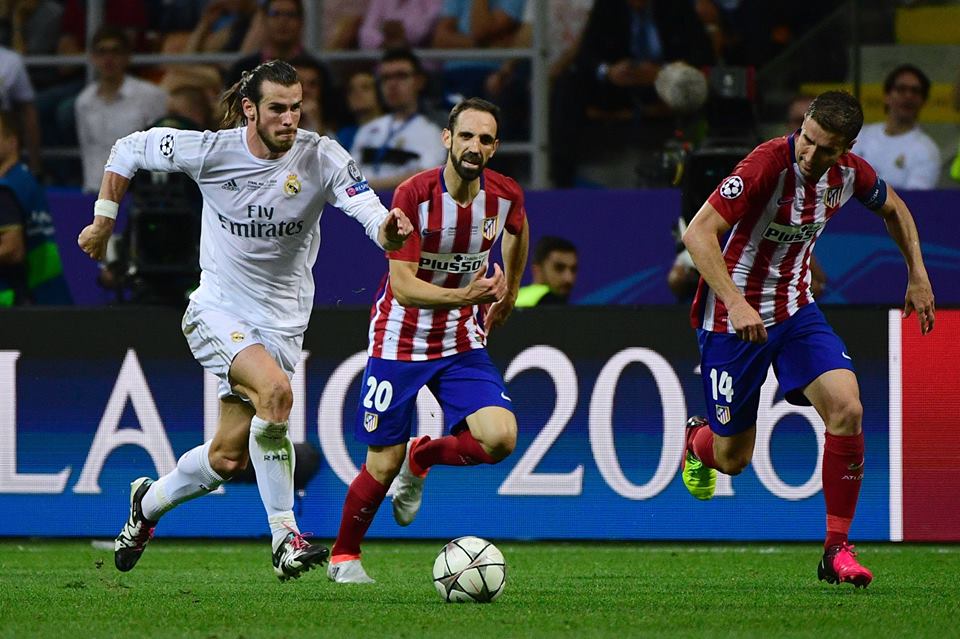Tactical Analysis | How Real Madrid ceded possession to pull Atletico out of comfort zone
Real Madrid lifted their 11th Champions League trophy on Saturday after beating their rivals Atletico Madrid on penalties. On the tactical front, Zinedine Zidane surprised Atletico by ceding possession, while Diego Simeone responded by testing Madrid's vertical compactness in the second half.

How they started:
Real Madrid XI (4-3-3): Keylor Navas (GK); Daniel Carvajal, Sergio Ramos, Pepe, Marcelo; Toni Kroos, Casemiro, Luka Modric; Gareth Bale, Karim Benzema, Cristiano Ronaldo;
Cristiano Ronaldo provided a big injury scare for the fans when he limped off during the training on Tuesday. He made it to the lineup, but the Portuguese international did not looked to be at his best on the pitch.
Zinedine Zidane made two changes to the team he fielded in the second leg against Manchester City—Casemiro replaced Isco in the three-man midfield, while Karim Benzema returned to his role up front in place of Jese. Casemiro's return was expected with the French manager feeling the need for more bite in the midfield.
Atletico Madrid XI (4-4-2): Jan Oblak (GK); Juanfran, Stefan Savic, Diego Godin, Filipe Luis; Saul Niguez, Augusto Fernandez, Gabi, Koke; Antoine Griezmann, Fernando Torres;
The only change Diego Simeone made to his team, from the one he fielded in the second leg against Bayern Munich. Stefan Savic partnered Diego Godin at the center of the defence with Gimenez looking on from the bench.

Atletico's pressing and Real's counterpressing
Diego Simeone has drilled defensive solidity and compactness into his side like few other, and one of their best-known characteristics is their pressing. Atletico's attackers pressed Real Madrid defenders, whenever they had the ball, high up the pitch and looked to force them into making mistakes. This not only spoiled Real Madrid's build-up play, but also created a goal-scoring opportunity for Koke in the 5th minute, who messed up the chance.
Atleti pressed RM really well in the beginning, RM couldn't really progress forward with the ball. pic.twitter.com/eQZng7Cy7c
— István Beregi (@szteveo) May 28, 2016
Interestingly, Real Madrid also displayed short bursts of counterpressing when they lost possession. Although, this counterpressing did not always help them in winning back the possession, it did disrupt Atletico Madrid's attempt to play fast counterattacks. This ploy largely handicapped Atletico's modus operandi in attack in the first half of the match. Simeone's men had 15 shots in the 90 minutes of normal time, and only 5 of those came in the first half.
Real Madrid troubling Atletico at set-pieces
Real Madrid also failed to create too many openings in the first half, with Ronaldo and Benzema failing to have any significant impact on the game, and they made Atletico look vulnerable from set-pieces. The first warning came when Casemiro came close to scoring from Gareth Bale's free-kick, only for Jab Oblak to make an outstanding save. Atletico were caught on their heels from the midfielder's late run into the box, and it was pattern that was followed for the rest of the game.
Real Madrid's opening goal arrived from another set-piece few minutes later, and although it was Sergio Ramos who got on the scoresheet, it was Gareth Bale who deserves credit for that goal. The former Tottenham made a run away from the goal, instead of running towards it. Although this run meant he was not a direct threat on goal, it relieved off his marker. Atletico's central defenders busy dealing with the likes of Ronaldo and Benzema inside the 'perceived' danger area, when Bale was free to flick on Kroos' delivery, which led to Ramos' goal. Although replays showed that Ramos was marginally in an off-side position when the flick happened, it was clearly a move practiced in the training ground, and Zidane should receive credit for it. Not many teams can rattle Atletico from set-pieces, and Real managed to do so.

Bale making the run away from the goal.
Real concedes possession to Atletico
It is not often that one sees Atletico Madrid with 55% possession in a game, especially against an opponent of such quality. Real Madrid sat back after taking the lead, and ceded possession of the ball to their opponents, who are not known for their ability to play possession football. In the first 15 minutes of the match, Real Madrid had 61.9% possession, in the next 75 minutes they had 45.9% of the ball.
This tactic aided Real Madrid in two manners. Firstly, it helped them in negating the threat Atletico Madrid possess from counter-attacks. Secondly, it allowed Casemiro to do what he does best—exert his influence on the midfield as a destroyer. Real Madrid are not known for their defensive shape as it is still a work in progress under their new manager. In fact, the best they managed was to keep the shape of the three-man midfield, and it made sure that all three of them stayed close to each other, most of the times.

Real Madrid's three-man midfield keeping their shape.
Although they started in a 4-3-3 formation, Real Madrid switched to 4-1-4-1 while defending, with Casemiro sitting in front of the back four. Bale and Ronaldo, although not as successfully as the former, dropped to the wings when Real Madrid did not had the ball, in order to provide support to the fullbacks, who were at times outnumbered on the flanks by Atletico. Although, Real Madrid were not able to maintain horizontal compactness throughout the game, something which was exploited by Atletico in the second half, it was the best they could produce at this point.
Simeone's response and the introduction of Yannick Carrasco
One of the reasons why Simeone is rated so highly is due to his tactical know-how, and the Argentine manager came up with a response to Real's tactic of ceding possession in the second half. The Atletico manager replaced central midfielder Augusto Fernandez with Yannick Carrasco and switched to a 4-1-4-1 formation. This gave them more numbers in the center of the park and helped them cope with the three-man midfield of their opponent.
The four layer 4-1-4-1 formation also helped in stretching the vertical compactness of the Real Madrid midfield, and space began to appear between the midfield and the defence. Atletico exploited this space in the 47th minute when Fernando Torres won a penalty. Griezmann was able to roll the ball to the Spanish forward through the space, before Pepe brought him down. Sadly, for Atletico though, Griezmann was not able to convert the resultant spot-kick.

Atletico using the space between the midfield and the defence during the Torres penalty incident.
Carrasco's arrival in the second half also added a lot of flair in Atletico's attack and Real Madrid fullback Danilo was at the receiving end of it. Daniel Carvajal's night was cut short due to an injury and Zidane replaced him with Danilo in the 52nd minute. The Brazilian defender was tormented by Carrasco on numerous occasion, and every time the Atletico attacker ran at him on the left wing, there looked like just one winner. So it was not wonder that it was Carrasco who scored the equalizer in the 79th minute, although this time he beat Lucas Vazquez to the ball at the far post.

Comments
Sign up or log in to your account to leave comments and reactions
0 Comments